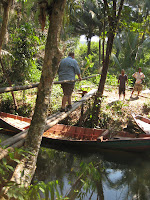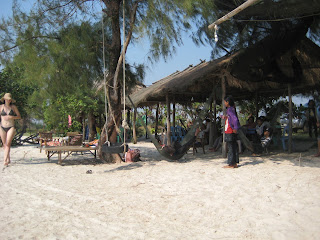

Lonely Planet describes Krong Koh Kong as a wild west frontier town, full of smugglers and dodgy hotels. Fortunately with Malcolm, the Welsh owner of 'Fat Sams bar' to guide us,we found a charming town full of entrepreneurs. As with everywhere else there was moto and tuk tuk chaos, a strip of tarmac for road and dubious drainage. Not being able to avoid farm visits any longer, we took a boat and had a trip up river into the mangrove forest on the southern edge of the Cardamon mountains. Taking a random selection of Malcolm's friends and guided by Noy we followed the jungle paths and saw small farms producing fruit, sugar cane, lemon grass (50 cents/kg) and Sandlewood. One progressive farmer was growing 4 ha of water melons, all without irrigation just relying on the heavy forest dews. We saw a lot of hammocks and mosquitoes but not much bird life, rumour has it that all the birds have been eaten and after trying the local spider delicacies at Skoun i can quite believe it.
The forest seem ed a good place to farm, far from the noise of tuk tuks and moto's and with plenty of fruit and nuts to harvest. In the Pol Pot era the jungle was a place that Khmer Rouge didn't go and many Cambodian's fled to the jungle to hide. Taking produce to market was a slow boat trip, Noy told us how the village we visited was innovative and good at their marketing.
ed a good place to farm, far from the noise of tuk tuks and moto's and with plenty of fruit and nuts to harvest. In the Pol Pot era the jungle was a place that Khmer Rouge didn't go and many Cambodian's fled to the jungle to hide. Taking produce to market was a slow boat trip, Noy told us how the village we visited was innovative and good at their marketing.
Noy farms 5 ha's and told us how
 he made sure he had 'hard papers' to prove ownership, he was proud to tell us that since buying the land 4 years ago he had improved the land and his yields of rice had increased. He was positive that farming had a future in Cambodia, but was worried about the misuse of sprays and fertilizers in a ecosystem that he was passionate about. When pressed why he farmed he eloquently explained the need to belong after spending his first 12 years in a refugee camp eating rice and dried fish. Owning and farming a piece of his homeland gave respect, security and freedom. Innovative, young and positive but realistic that he was only just starting to make a success of the farm. Facing the familiar problems of lack of capital, he seemed to have the resilience that we saw in the Cambodian people to survive and enjoy live as it happens.
he made sure he had 'hard papers' to prove ownership, he was proud to tell us that since buying the land 4 years ago he had improved the land and his yields of rice had increased. He was positive that farming had a future in Cambodia, but was worried about the misuse of sprays and fertilizers in a ecosystem that he was passionate about. When pressed why he farmed he eloquently explained the need to belong after spending his first 12 years in a refugee camp eating rice and dried fish. Owning and farming a piece of his homeland gave respect, security and freedom. Innovative, young and positive but realistic that he was only just starting to make a success of the farm. Facing the familiar problems of lack of capital, he seemed to have the resilience that we saw in the Cambodian people to survive and enjoy live as it happens.
After such thirsty farm visits the rest of the day revolved round paddy's bar where the toilets are unmentionable but the food is excellent (try the noodles they are amazing), I began to think that Cambodian farming may be more fun than we first thought.



















